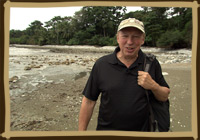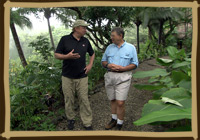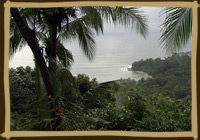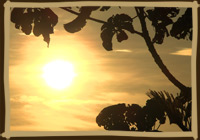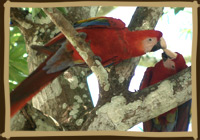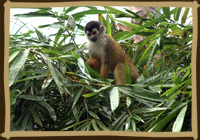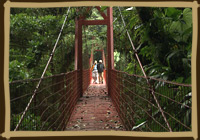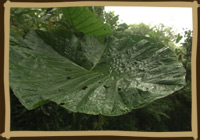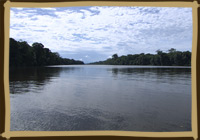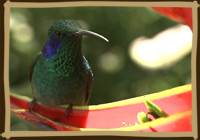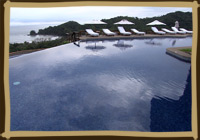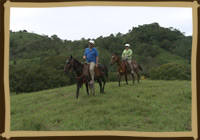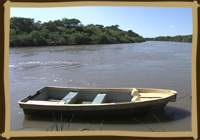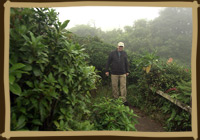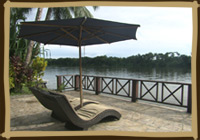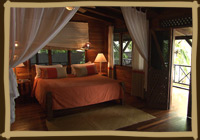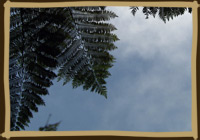
Richard On-Camera: We're exploring the ecological nexus between North and South America, the small but potent package of a country, Costa Rica.
Richard Voice-Over: The people here are on a tear to preserve the extravagant biodiversity of their national field of dreams—and it seems to be working.
R OC: What is the secret of their success? We're off to find out, as we traverse a land often cited as a green beacon to the planet, and a place that two recent international studies proclaimed “the happiest country on earth!”
[Adventures with Purpose -- standard opening]
R VO: Costa Rica is a place of rivers wild to get to the sea, of mountains that speak with fire, and rainforests that obey no rules. It has more species of animals and plants than the United States and Canada combined. An ethnically diverse democracy, Costa Rica has literacy rates and healthcare comparable to the most developed countries in the world. It’s abolished its military, and enjoyed greater peace and political stability than all of its neighbors. But what has brought me back to Costa Rica so many times over the years is a sense of well-being I’ve felt in few countries on earth.
R OC: ‘Pura vida.’ It’s a phrase I’ve been hearing ever since I came to Costa Rica years ago. At some point I realized I had heard it everywhere throughout the country, uttered by everybody from guides to park rangers to bus drivers, even bureaucrats. But until recently, I never really considered what pura vida meant. I know that literally it means “pure life,” but does it go deeper? Could it in some way be a clue to the roots of Costa Rica’s exceptionalism?
R VO: Here, endless natural wonders rouse the faculties and excite the soul. But what I find most remarkable is the sensitivity the people have to their surroundings. Costa Ricans have set aside one quarter of their land as national parks and protected areas. How did they manage this when so many people in other countries have stood by while their natural wonders were degraded or destroyed?
R OC: How did Costa Ricans fend off the miners, loggers, farmers, burners, developers and others who felled and flattened rainforests around the world? How did they trick time?
R VO: My friend Michael Kaye has lived in Costa Rica for more than 30 years, and was first to raft the white water rivers here. He and his wife, Yolanda, also founded Costa Rica Expeditions and some of the country’s first ecolodges.
RB: So, Michael, why does Costa Rica seem to have this almost exceptional ethos in conservation and is there any relationship with pura vida?
Michael Kaye: Richard, I’ve been trying to figure this out for 30 years, and I really haven’t been able to. But maybe I can find some people to shed some light on that.
RB: I’d like that.
MK: Okay, great.
R VO: Costa Rica is the arm that reaches two continents; the hand that touches two seas. We’ll begin our journey on the Pacific side, in the ecological mosaic of Corcovado National Park.
R VO: Corcovado is the ark of Latin America. It holds a mind-bending amount of ecological variety. National Geographic called it "the most biologically intense place on Earth." Corcovado’s profusion of wildlife thrives on an equally staggering range of vegetation, including at least four different kinds of forest, encompassing some 500 species of trees.
R VO: It was geological serendipity that formed Costa Rica, ancient tectonics that created a narrow land bridge linking the continents of North and South America. For millennia it’s served as a longitudinal corridor for animal and plant life, a breeding ground for a riot of adaptations, and part of a tropical hotbed that conservationists call “The Path of the Panther.”
R VO: Because of the remoteness of Corcovado, the logging that threatened much of Costa Rica didn’t start here until the 1960’s. By 1975 there were plans for a major international logging operation. At the same time, scientists and conservationists became alarmed about the effects of development on the area’s biological richness and they strongly lobbied Costa Rica’s president to protect the area. In spite of protests from locals, and even some in his own cabinet, the president recognized the value of protecting Corcovado and declared it a national park.
R OC: When the Spanish conquistadores first arrived on these shores in the sixteenth century, they found a rugged and luxuriant land that had been occupied by pockets of indigenous people for millennia. Whether by design, accident or destiny, the conquistadors ended up conquering more than just boundaries here.
R VO: Most of the original peoples perished from European diseases, such as smallpox, and from ill-treatment by the Spanish invaders. But unlike other parts of Latin America, Costa Rica’s difficult terrain didn’t lend itself to easy colonization.
R VO: The region was largely neglected by the Spanish Empire, which was much more interested in developing the silver and gold mines of Mexico and Peru. European settlers in Costa Rica were left mostly to their own devices, and historians think this contributed to the country’s evolution as a more egalitarian society than many of its neighbors. Today it is home to a distinctive mix of people, most of whom are immigrants or descendants of immigrants from countries and ethnic groups around the world.
R OC: Thirty years ago Costa Rica was little known to the outside world and was rarely found on a traveler’s itinerary.
R VO: Surfers in the ’60s were among the first to discover the fury and thrill of these shores. They mostly kept the secret to themselves until articles in National Geographic and the Smithsonian gave the rest of the world a preview of an endless summer escape far, far south of the border. Soon the country was riding a wave of enthusiastic reviews from those who discovered a vacation getaway with safe travelling conditions, friendly locals, and seemingly limitless opportunities for pure adventure. Was it the glint of pura vida?
R VO: In the heart of Corcovado Park, Sirena Ranger Station is a hub for pathfinders in what is a “modern age of discovery.” Corcovado, like about a dozen other parks in Costa Rica, employs a creative membership program called Amigos de los Parques Nacionales that allows the public to participate in park conservation. More on that later.
R VO: There are so many birds in Corcovado; the tropic breeze is alive with color. Tiny frogs, carrying pockets of poison, hop like raindrops. Here is a supple universe. Here water conquers stone.
R VO: Alvaro Ugalde, once named Time Magazine’s "environmental leader of the century," has dedicated nearly 40 years of his life to conservation issues. As a biology student in the ’60s, Alvaro became alarmed at the rapid destruction of Costa Rica’s forests.
Alvaro Ugalde: In a matter of three decades we went from 50% forest to 20% forest. I found that Costa Ricans were already uneasy about more fires in the dry season, less water. And they talk about the animals that used to be around and no more animals. The Congress had already approved some legislation that would open the door for people to do conservation.
R VO: For much of his career, Alvaro worked from within the government to expand the park system.
AU: My inspiration is to keep Costa Rica the way it is.
RB: What do you think about foreign visitors when they come here? What should they do? What should they bring home?
AU: They should take home a better understanding of their own personal responsibilities in their home. Either we all do what we have to do as individuals, or it’s going to be very difficult to move forward from here on.
RB: I’ve been to Costa Rica a few times and visit some of the parks. And every time I come here I seem to meet people in and out of the parks who say pura vida. What does that mean?
AU: I think the fact that we perceive ourselves as a happy nation has a lot to do with it. And pura vida just became a symbol for happy Costa Ricans. And for friendly Costa Ricans.
R VO: Costa Rica’s environmental success is hugely dependent on strong partnerships between government agencies, local communities and business leaders, such as Steve Aronson
Steve Aronson: I first came here in ’69 as a student. I was hitchhiking from Columbia to Ann Arbor Michigan. And I was struck by this place. So then I started to think about ways to come back.
R VO: Founder of a successful coffee company, Steve now works with other community leaders to make the park system sustainable.
SA: The lines are blurred between public and private, and the lines are blurred in a positive way. If 25% of our land is protected land, then this is a consideration of the whole country. And one of the strengths of Costa Rica and one of the attractive parts of Costa Rica is that it’s an organic entity, we feel like we’re part of a family. This is our land; this is where we are, so it’s not only the responsibility of some government agency. It’s the responsibility and the mission of everybody who lives here and everybody who visits.
R VO: Corcovado affords protection for many threatened animal species. With the help of local guide Felipe Arias, we embark on a raw adventure in search of the elusive Baird’s tapir. The unruly, rain-steeped jungle offers no impediment for Felipe. He was born right here in what is now Corcovado. After the government incorporated his family’s farm into the park, Felipe resorted to hunting, gold mining and even poaching to survive. With help from Michael Kaye and others, he found a new mission: leading visitors through the park. Today he is one of the most skilled and sought after guides in Corcovado.
Felipe: Before I kill a lot of animal and eat two or three day for the same animal. Now I respect a little bit more the nature. Now I looking for the animal, not to kill but to take picture with the tourists only. I eat many times with the same animal.
R VO: At last, we gingerly approach the resting tapir, an endangered mammal closely related to the horse and rhino, and similar in size to a pig. Human hunters and habitat loss are major factors in the species’ diminishing numbers. But here in Costa Rica sustainable forestry practices extend a glimmer of hope for the tapirs’ survival.
R VO: The Lapa Rios Ecolodge unfolds in a private nature reserve spread over a thousand acres of Central America's last remaining lowland tropical rainforest. The owners designed it as an eco-destination that could demonstrate that a forest left standing is a much more valuable, more sustainable, source of income to the community than one cut down. The lodge employs only local residents, uses community suppliers, and is committed to environmentally sound practices.
R VO: Today, Michael and I will make a short stop at the Nectandra Institute before heading for the rarified air of Monteverde Cloud Forest. Surrounded by luxuriant gardens, the Nectandra Institute carries on the work of promoting conservation throughout Costa Rica.
R OC: Rare plants are common here, and common plants are rare. But what becomes most evident is that the water cycle and life cycle are one. And one of the missions of the Nectandra Institute is to help communities with the tools and information to better manage the relationship between healthy forests and clean water.
R VO: Evelyne Lennette was so impressed by the work done by the founders of Costa Rica’s Parks System that she wanted to make her own contribution.
Evelyne Lennette: They set aside 25%. So I got to thinking, but that’s only 25%, what happened to the remaining 75%? We can certainly nibble on that 75% and see what we can do with it.
R VO: She and her husband bought a large tract of land to create Nectandra, a private reserve and research garden. With several partners, they formed a grassroots-style outreach that includes everything from educational workshops, to an innovative eco-loan program in which locals receive money to buy watershed land. The borrowers then repay interest by doing labor to restore and protect that land.
EL: The water is the central link among the forest, ecology, life as we need and the future. So without it we have no life. And that’s the only message we need to get across to the young ones.
R VO: While other parts of the world can rely on glaciers to act as water reservoirs, here there is no natural reservoir. The forests are essential for preventing runoff.
EL: There’s no way to hold that water, even with torrential rain, it goes out. So without the forest, we have no water. So that’s a very powerful link for the association members, the parents of these children. They know that unless they put the forest back, the kids will not have the water in their lifetime. You always are taught that you need to pay back. If you benefit, you should also put back in. When I came here I saw that this is a natural beauty and we need to take care of it. So that’s my little tiny contribution to put back in a little bit of my time on this planet.
R VO: Roiling in fountains of mist, the Monteverde Cloud Forest has a magical realism about it. It seems a place to grasp the mystery that breathes behind things. Even humidity here is at its purest: 100%.
R VO: Several different kinds of forest thrive in Costa Rica, and Monteverde, literally “green mountain,” is a house of spirits to the cloud variety. Warm, moist, air sweeps in off the ocean and is pushed upward by mountain slopes, where it seems to fill the infinite.
R VO: On the forest fringes shimmers the village of Monteverde. In another twist on Costa Rica’s history of diverse immigration, the village was founded by Quakers who moved here from the United States in 1951. They wanted to leave behind the constant threats of war, and the obligation to support the US military through taxation.
Marvin Rockwell: When the United States passed their Universal Military Training Act of 1948, four of us in the Fair Hope, Alabama Friends meeting, Quaker meeting, refused to register for that draft law. So we were arrested and sentenced to a year and a day in prison. So after we were released from prison, we and others in the meeting got to talking about it and decided, well maybe we ought to leave the United States. One couple of the group that was interested in moving came with a tour visiting all the countries of Central America and they returned and said: “Costa Rica’s much better than any of the other Central American countries, better economy, more stable government, the rich are not as rich and the poor are not as poor—and they abolished their army in 1948.”
R VO: So seven families from the US traveled here and started dairy farming on the pastoral foothills of Monteverde. Their thriving business now produces more than 8,000 pounds of gourmet cheese a day.
RB: And so how does the community accept the Quaker community?
MR: We’ve had good relations with our neighbors ever since we came. Several of us have married Costa Ricans; my wife is Costa Rican. We didn’t want to come down and be a little group of North Americans set down in Costa Rica. We wanted to become part of Costa Rica. And I think we’ve done pretty well.
R OC: So the early Quakers who settled here set out to farm the land, but they recognized the merit in preserving the cloud forest above them and the watershed that fed their fields. So they set about preserving a large tract of land that became the biological reserve.
R VO: The reserve unwinds with a well-maintained network of trails, and exploring them is like hiking through a grand green cathedral. Life is exuberant and pure here. I can almost inhale the incense of pura vida surrounded by these massive ropes of vines and fairy chains of moss.
R OC: Here we’re at the top of Monteverde and we’re on the Continental Divide. So if I pour water in this direction it goes all the way to the Atlantic Ocean, and if I pour it in this direction it goes all the way to the Pacific.
R VO: As we descend the mountain slopes, the flickering wings of countless hummingbirds hypnotize with their iridescence. Hummingbirds are found only in the new world, but they spark fascination among bird lovers around the globe. Like all animals, they are vulnerable to habitat destruction and climate change. More than 25 species of hummingbird are currently threatened with extinction.
R VO: But the outlook for Costa Rica’s wildlife feels optimistic as we climb on bikes, the vehicles of poets, to explore the countryside around Monteverde. While other forms of transport sequester us from the natural world, the bicycle intersects. It allows the purity of childhood wonder.
R VO: To end the day, we happily succumb to the comforts of the Monteverde Mountain Lodge. Wrapped along the edge of the cloud forest, the lodge is 4,600 feet above sea level. Staying here has a sort of paradoxical effect: making us feel like we’re ensconced in the middle of the forest, while feeling protected from the misty breezes that buffet nearby mountain peaks.
R VO: Nearly two thirds of Costa Rica's borders are coastline. The small town of Punta Islita is a precious stone set on the silver sea. Here are the riches of paradise. The Garden of Eden, an image so deeply implanted in Western lore, with roots in both classical and biblical soil, is the place to which we all long to return. And this garden of surf and sand and swaying palms has that same pull. Could the path to pura vida lie somewhere between the natural world and our interpretations of it?
R VO: Hotel Punta Islita has a well-deserved reputation not only as a sumptuous resort in a rapturous setting, but also as an environmentally responsible citizen and a vital economic spark for the local community. The hotel’s been lauded by Costa Rica’s Certification for Sustainable Tourism program for its green policies. And while it’s always a good idea to double-check any hotel’s eco claims, Punta Islita has earned its stripes.
Maria Barquero: What really differentiates the hotel is that it’s fully integrated with the community. So it’s really made a concerted effort to incorporate the community into the guest experience.
R VO: The community of Punta Islita is both a village and an outdoor Museum of Contemporary Art. With support from the hotel, well-known Costa Rican and international artists work together with budding local talent to create artistic visions on village buildings, and to craft small personal works of art. The result is something beyond the typical tourist trinkets.
Marta Figaroa: And actually that’s something that we’ve really tried to instill in the participating community artists, I mean that they are transcending crafts. They create unique and meaningful pieces that truly reflect their experience, their landscape. So they’re very deep and very meaningful.
R VO: This is the first contemporary open-air art museum in Latin America, and its success has helped locals remain in their rural homes rather than being forced to look for jobs in the city. With theme and focus on conservation and community building, perhaps this is pura vida at its most felicitous expression.
R VO: Punta Islita is encircled by a singular stretch of tropical dry forest—another endangered ecosystem that is home to hundreds of types of birds, mammals and tropical flowers. For adventure seekers, there’s really only one way to see the forest: on an adrenaline-charged zip line ride.
R OC: It’s like flying without a plane. Being a bird on a wire. Arguing against the laws of gravity....
R VO: Zip-lining is the sport of soaring above the ground while secured in a harness attached to an overhead cable. The rider whirls over dark trees, a feather swept before a storm. All troubles are left on the ground. Suddenly we’re in touch with our prehistoric roots, swinging like ancient primates through the jungle.
R VO: Beauty, spirit, freedom and grace are hallmarks of Costa Rica. And that could as well be said of its horses. The land here sings with hoof beats. In riding, we borrow wildness; we pirate wings.
R OC: Horses wrote history here. When the Spanish conquistadors first introduced these quadrupeds to Costa Rice, it was the beginning of a long and meaningful relationship.
R VO: Horses were instrumental, and were instruments, in settling the land. Spanish immigrants excelled in horsemanship and used their skills for cattle ranching, and eventually for cultivating coffee and banana plantations. Horse travel allowed greater mobility along narrow mountain paths and into dense jungles. Even now, watching a horse in motion, I wonder if the cadence I hear could be the rhyme and music of pura vida...
R VO: Michael’s friend Rocio is executive director of a nonprofit organization whose sole client is the National Parks of Costa Rica.
Rocio Echeverri: When I was a looking for a new job five years ago, I knew that I wanted to work with the environment. I wanted to work for a cause, something that was fulfilling, so that’s why I took the job and have been working ever since. And I love it.
R VO: She urges us to visit Palo Verde, a national park in the northwestern part of the country close to where she grew up.
R VO: Stepping into Palo Verde National Park, we enter a plumed and twittering kingdom. Again we use our passes from Amigos de los Parques Nacionales to enter the park. It’s easy to get a membership online and the proceeds go toward supporting the park system and helping the park rangers.
RE: So basically we try to help out the rangers that are stationed at national parks so that they’re better trained or have better equipment. An example is that we’ve established broadband connections to a lot of parks. And what is so interesting about this is they’re in very remote areas sometimes and by having Internet access they can not only communicate with their families, but we open the world up to them. They can start doing research and all types of things that are very useful for their work.
R VO: This wetland sanctuary harbors one of Central America’s largest concentrations of aquatic birds, and is the most important migratory site of the region. Thousands of ducks and geese stop in from North America keen on finding some balmy winter weather, just like human counterparts. More than 300 species have been recorded here, including the only permanent colony of scarlet macaws in the dry tropics. Meanwhile on the ground, peccaries snuffle along in search of seeds and edible roots.
R OC: This type of wildly diverse ecosystem once covered most of Central America’s Pacific coast, but was systematically destroyed over the centuries. Sometimes the dispatch was made by small farmers, but very often by huge logging, plantation, and cattle companies, and sometimes even by shortsighted governments intent on quick profits.
R VO: But this park has thwarted those tides. It remains thrilling in its diversity. Wild plants and fruit grow in abandon, nourishing legions of insects and self-propelled flowers they call butterflies. Like happiness, is pura vida a butterfly which, when pursued, is always beyond the grasp? But if we sit down quietly, may it alight upon us?
R VO: Balancing long-term sustainability with today’s economic realities is never an easy proposition. Travelling east, we happen upon a banana plantation and packing plant. Bananas were first planted in large numbers here in the late 19th century as an inexpensive way to feed railroad workers. As more and more of the fruit was shipped to the United States, it soon came to rival coffee as the country’s principal export. Today tensions run high between this profitable industry and local environmentalists, who assert that fruit plantations—run mainly by large foreign corporations—are damaging parts of the eco-system with the toppling of trees, erosion of the soil, and the use of pesticides.
R VO: One place where nature wins out is Tortuguero National Park, stretching along the Caribbean coast for thirteen miles. This park is a pastiche of fertile river deltas. This area was once an archipelago until alluvial sediments from interior mountains filled in the gaps, forming a network of marshlands. With 11 different ecological habitats, accessible only by boat or light aircraft, Tortuguero marches not just to a different drummer, but to a whole different band.
R VO: The serpentine network of canals and lagoons takes us on yet another ecological treasure hunt, trailing some of planet Earth’s most distinct denizens.
R VO: The easy lines of Tortuga Lodge meld breezily into a backdrop of tropical trees and orchids. Soft-scented air drifts through ecofriendly rooms that make visitors feel in sync with the rhythms of the park beyond. This was the first nature lodge in the area; a vision of Michael’s actualized.
RB: What are the characteristics, what are the things you have to do to get it right?
Michael Kaye: You have to put the lodge near a park that will be kept in its natural state in perpetuity. The other you have to do to do it right is even if the park’s protected, you have to pick a park that you really love being in because you’re going to be there, that you can really give people a wonderful experience in so that they’ll tell their friends to come back, and where you have very, very good people, local people, to teach you about the resource and to work with so that they’ll make your guests happy and you’ll be very happy working with them.
R VO: One of those happy guests is Costa Rica’s vice president, Luis Liberman, who comes back year after year to fish with his friend and guide, Eddie Brown.
RB: We’re in a region, a larger region that is not particularly known for its political stability, but Costa Rica is the exception, it’s the longest running democracy in Latin America. How did that happen?
Vice President Luis Liberman Ginsburg: People here are very independent. We haven’t had the hacienda type of culture, we never did. And our political culture developed basically in the 1800’s, late 1800’s, in the 20th century, becoming every time more democratic. There was a lot of educated people, people educated in Europe, and educated locally, that really believed power should be elected, not grabbed, and I think we take it very seriously.
R VO: The country’s proactive approach to preserving their green spaces tested that democratic process.
LLG: We cannot inherit our kids a desert. And some people didn’t like the idea that we were creating national parks or protected areas, but it has become kind of a national religion.
R VO: He describes how national support has shifted away from quick-profit industries, such as mining, towards a more sustainable mindset.
LLG: My dad, when he was a young man in Costa Rica, he used to buy gold in Porto Jimenez and sell it in San Jose. And now we decided we don’t want to destroy Corcovado, it’s worth it more forest, animals, and the whole environment around it than digging for gold. And the younger the kids, the more committed to that they are.
RB: That’s exciting.
LLG: And hopefully some day we can increase even the area of protected areas.
R VO: One of Michael’s passions is puzzling out new ways to help guests at Tortuga Lodge get more engaged with local culture.
MK: A vast number of our guests, a great majority of our guests, really want to feel like they’re helping the local community. And what they can do best that the local community really learns is help kids learn English. Because English is the one thing that I can think of that I know 10 to 15 years from now is going to be really valuable to these kids no matter what they end up doing.
R VO: He conceived of program in which English-speaking guests can volunteer to help kids from the local village learn English. This gives the children the chance to practice their language skills, and guests get to meet local families and learn more about Costa Rican culture.
R VO: Evening spawns subtle changes along the canals of Tortuguero and the jungle wraps itself in secrets. At Jalova Station, near the south end of the park, a surprise awaits: a gourmet dinner featuring a bounty of local ingredients.
[Valentin Corral explaining dishes in Spanish while Michael translates.]
R VO: Costa Rican cuisine, which relies heavily on fresh produce, is known for its panoply of subtle flavors.
R VO: As first tinges of daylight mark the sky, we creep along the beach for a glimpse into one of nature’s marvels: turtle hatching. Tortuguero is best-known as a breeding ground for endangered turtles—the largest population in the world—and no place is more critical to the survival of the Caribbean's Green sea turtle. Throughout the first half of the 20th century, these turtles were hunted to near extinction. Working closely with the Costa Rican government, the Caribbean Conservation Corporation helped establish Tortuguero National Park in 1970, a move that offered protection to the turtles and strictly controlled access to remaining populations.
R OC: For some of us, life is paddling. Everything else is just marking time. For the grand pyrotechnics of this journey, Michael has arranged for a raft trip down the Pacuare, a river he pioneered, on waters we have shared many times.
R VO: And he’s invited along some of the heroes of our story, the people who care so deeply about this Eden-like land called Costa Rica. Michael was first to mine many of Costa Rica’s white-water riches, and for him rafting epitomizes pura vida.
R VO: Costa Rica is like the monkey who locked up the zookeeper. It’s put away the constrained thinking that keeps others stuck in unproductive routines, and allowed its wildness to escape the margins. Here we can test our mettle, hear our hearts race, and even encounter a bit of danger. This is a world where the white water of ‘pure life’ splashes you in the face.
R OC: It isn’t pura vida alone that drove Costa Rica’s enlightened environmental policies. It seems to be some sort of magical convergence—a coming together of geographical providence, a truly farsighted people, and perfect timing.
R VO: It was a land too rugged to allow easy exploitation. It was a moment in time when a global appreciation of the environment was beginning to ignite, and there were leaders and visionaries who unroofed the odds and set about establishing a national park system, as well as eco-tourism infrastructures, that delighted all who came to see.
R VO: But perhaps what makes Costa Rican culture so evolved is that many different people from very diverse backgrounds have created something greater than the sum of their individual efforts. Biologists have a concept called hybrid vigor. By that they mean that cross-breeding different strains of animals or plants results in something stronger than the individual strains. The same holds true for societies, and Costa Rica is a poster child. Pura vida is not the cause of Costa Rica’s uniqueness; it is the expression of it.
R OC: Conservation is never a done deal. Even here in Costa Rica, it’s a contest without end. But no place glows warmer with the spirit of joy, hope, and inexhaustible promise, and the attendant feelings of a bright, unspotted life. Not only does Costa Rica have its home-grown heroes, it is a hero to the rest of the planet: a magnet and a model for ecologists, adventurers, researchers, and all who want to experience the magic of pura vida and be part of this luminous stitch in time.
R VO: What you can do:
- Join Amigos de los Parques Nacionales.
- Volunteer for park preservation projects in your own area.
- Stay in locally owned ecolodges with genuine eco policies.
- Visit Costa Rica and see for yourself.
R VO: For more information and links visit our web site: AdventuresWithPurpose.tv.
